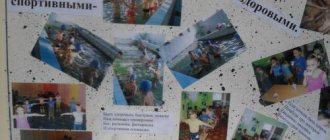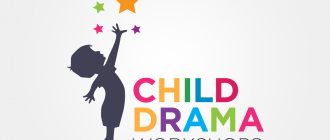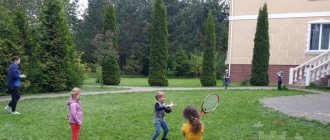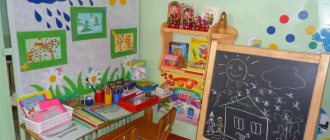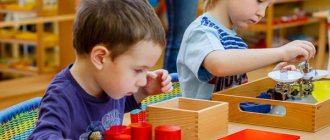Consultation for teachers “Music Corner”
Music corners should contain:
- Neo-sounding musical instruments;
- O sonorous musical instruments;
- Musical toys;
- Homemade musical instruments;
- Musical and didactic games;
- Technical means (audio and video recordings).
The corner is updated 1-2 times a quarter!
- introduce new musical and didactic games,
- new equipment and homemade musical instruments.
“Musical corner of the 21st century” or “Modern trends”
The group must have audio and video equipment, CD and DVD players, headphones (for older preschool age), so that one child does not disturb others while listening to music.
A selection of children's contemporary songs and classical music in accordance with the age category of children.
High-quality sound of musical instruments (including electronic ones), i.e. well-tuned and producing sounds familiar to children (so as not to pollute the child’s auditory experience).
Answer the questions:
- What is the main purpose of the music corner:
- teach musical literacy
- develop creativity
- cultivate aesthetic taste
- strengthen the physical and mental development of the child?
- What levels is the music corner divided into and why?
- How many times are manuals and materials updated per year?
- What do modern trends require?
Musical corners in groups.
List of materials for children from 2.5 to 4 years old
(1st and 2nd junior groups):
- tumbler dolls;
- figurative musical “singing” or “dancing” toys (cockerel, cat, bunny, etc.);
- toys-instruments with a fixed sound - organs, organs;
- toys-instruments with a sound of indefinite pitch: rattles, bells, tambourine, drum;
- a set of unvoiced figurative instruments (accordions, pipes, balalaikas, etc.);
- attributes for musical outdoor games;
- flags, plumes, scarves, bright ribbons with rings, rattles, autumn leaves, snowflakes, etc. for children's dance creativity (by season);
- table screen with glove toys;
- tape recorder and a set of software audio recordings;
- singing and moving toys;
- musical pictures for songs, which can be made on a cube and in the form of a large album or individual colorful illustrations.
List of materials for children 4-5 years old
(middle group of kindergarten):
In the music area for independent activities of children 4-5 years old, it is advisable to have:
- glockenspiel;
- noise instruments for children's orchestra;
- little books “We Sing” (they contain bright illustrations of familiar songs);
- flannelograph or magnetic board;
- musical and didactic games: “Three Bears”, “Recognize and Name”, “In the Forest”, “Our Orchestra”, “Seven-Flower Flower”, “Guess the Bell”, etc.;
- attributes for outdoor musical games: “Cat and Kittens”, “Hen and Cockerel”. “Hares and the Bear”, “Pilots”, etc.
- musical ladders (three-step and five-step, on which there are small and large birds or a small and large nesting doll;
- ribbons, colored scarves, bright plumes, etc. (attributes for dance improvisations, but for the season;
- table screen and a set of toys;
- musical toys (sounding and noise) for creative music making:
- tape recorder and a set of software audio recordings.
List of materials for children 5-6 years old
(senior kindergarten group):
In addition to the middle group materials, the following is used:
- rattles, tambourines, drums, triangles, etc.
- musical toys-instruments with diatonic and chromatic sound (metallophone, piano, button accordion, accordion, flute);
- illustrations on the theme “Seasons”;
- homemade musical toys (noise orchestra);
- portraits of composers;
- illustrations from the “Musical ABC Book”;
- musical and didactic games: “Bee”. “Musical Lotto”, “Recognize and Name”, “Steps”, “Repeat the Sounds”, “The Three Little Pigs”, “Magic Top”, “Musical Train”, “Guess What Sounds”, etc.
- attributes for outdoor games (“Round Dance in the Forest”, “Raven”, “Cat and Mice”, etc.);
- children's drawings for songs and familiar pieces of music;
- screens: tabletop and screen according to children’s height;
- three-, five- and seven-step musical stairs - voiced;
- attributes for children's dance creativity: elements of costumes for familiar folk dances;
- multi-colored feathers, multi-colored gloves for musical improvisations behind a screen and other attributes;
- attributes for dance improvisations according to the season - leaves, snowflakes, flowers, etc.):
- a tape recorder and a set of software audio recordings or disks.
List of materials for children 6-7 years old
(preparatory group of kindergarten):
- musical instruments (maracas, tambourines, harp, children's piano, metallophone, bells, triangles, flutes, drums, etc.);
- portraits of composers;
- illustrations on the theme “Seasons”;
- pictures for the manual “Musical ABC Book”;
- albums: “We draw a song” or “We draw and sing” with children’s drawings, in which they reflect their emotions and feelings about the pieces of music they listened to and their favorite songs;
- graphic aid “Emotions” (cards depicting faces with different emotional moods) to determine the nature of the melody when listening to works;
- albums for viewing: “Symphony Orchestra”, “Folk Instruments”, “Dances of the Peoples of the World”, etc.;
- musical stairs (three-, five- and seven-step - voiced);
- a set of homemade instruments for a noise orchestra;
- musical and didactic games: “Three Little Pigs”, “Three Flowers”, “Musical Umbrella”, “Ri”, “Rhythmic Cubes”, “Name the Composer”, “Funny Record”, “Musical Chicks”, etc.;
- attributes for outdoor games (for example, “Hello, autumn”, “Cosmonauts”, etc.);
- attributes for children's dance creativity, costume elements for familiar folk dances (kerchiefs, wreaths, hats) and attributes for dance improvisations according to the season (leaves, snowflakes, flowers, etc.); multi-colored gloves, plumes, gauze or scarves, multi-colored ribbons, multi-colored feathers for music and dance improvisations; tape recorder and a set of software audio recordings or disks »
CONSULTATION FOR TEACHERS
TOPIC: ROLE OF THE TEACHER IN MUSICAL CLASSES AND HOLIDAYS
Among the many recent problems related to preschool education, the problem of interaction between educators and specialists stands out. And the problem of pedagogical interaction between the teacher and the music director is one of the most important: the success of the process of not only musical, but also the general aesthetic development of preschool children depends on its solution.
We, music directors, would like to see the interest of teachers in the process of music lessons. When a child sees that the teacher completes all the tasks with interest, he becomes involved in the process with even greater inspiration. After all, the teacher is an absolute authority for him, and no matter what happens in class, the child will constantly focus on the teacher.
How does a teacher’s interest in a music lesson show? First of all, the teacher needs to understand that in a music lesson he is as much a participant as the children, and not an overseer. Imagine that you are a child, everything is interesting to you and you and your children cheerfully sing songs, dance fervently, listen to music thoughtfully... And you do this not as a duty, but with your soul, but do not forget that there is a pedagogical process that needs to be controlled.
And now let’s move on from aesthetics to organizational issues.
SO:
1. During a music lesson, children should be smartly dressed,
wear comfortable shoes, girls must wear skirts.
2. starting from the middle group of children, it is necessary to build, alternating
boy and girl.
3.You should arrive to class 2-3 minutes before the start so that
line up and get the children ready for the activity.
4. The teacher brings with him a notebook with a hard cover on
spirals and pen to write down words of songs, games, movements
dances, recommendations, etc.
5. During class, it is advisable not to leave the hall, so as not to
skip some material.
6.Do exercises with the children. Movements of dances, games,
sing songs, etc.
7.Monitor the children’s movements correctly
8.Before class, it is necessary to maintain musical silence: do not
turn on the tape recorder, since children have hearing loss
perception and concentration
9. In free activity, consolidate the material received in class.
Nitophone, audio materials.
Features of creation
To begin with, let’s analyze the possibility of artistic and aesthetic development of children in a preschool institution. Musical corners in kindergarten are a way to inform children and parents about the impact of art on the development of the emotional qualities of children. Thanks to music classes, children develop diversified, improve their oral speech skills, and improve their auditory perception.
By mastering rhythm skills, it will be easier for children to learn mathematical operations while studying at school. At the age of 1.5-3 years, preschoolers acquire the skills of extracting sounds from simple musical instruments and consciously use the terms “ri.
The teacher periodically updates the music corners in the kindergarten, placing relevant and useful information in them.
Work in the middle group
With children 4-5 years of age, the music worker not only learns songs and dance movements, but also teaches children to play simple musical instruments and involves them in play activities.
For example, as part of a lesson aimed at learning strings, wind, and percussion instruments, preschoolers are invited to try themselves as performers of certain rhythmic compositions. During the game, the teacher first voices a rhythm, then the kids try to repeat it one by one. This technique contributes to the early identification of musical and talented children and their subsequent development. The teacher encourages children to improvise in various types of musical activities: dance composition, melody, chant.
Goals of creating a music corner in a preschool educational institution
It consists of instilling and improving the individual abilities of preschoolers, developing the skills of emotional response to musical and song images. The teacher instills in his students a culture of listening to music. The teacher himself decides what to call the music corner in kindergarten. It is desirable that the name resonates with the art. For example, you can design a corner “Merry Notes”, or create a “Song Gallery”.
Children, after listening to vocal or instrumental performances of rhythmic melodies, try to convey their meaning through movements or words. This helps improve their communication skills.
Musical games for children are aimed at developing logical thinking and perseverance. For example, in the game “Repeat After Me,” kids make the same movements to the music as their teacher. As soon as the music stops, they must sit on the chairs and “hide in their house.”
Children are happy to be involved in all musical activities in kindergarten and become active participants.
Forms of musical work in preschool educational institutions
Among them, we note integrated and standard classes. A music corner in a kindergarten, the design of which is undertaken by the music worker himself, contributes to the children’s positive attitude towards the lesson. The teacher only accompanies the children to class and acts as an organizer.
The children come to the music room in kindergarten with him. Rhythmic and musical games, listening to songs and compositions are also included during walks and excursions.
Components of work
The vocabulary of preschoolers aged 5-6 years includes the following musical terms: forte, minor, piano, major, staccato, legato. It was during this period that children’s ideas about the musical culture of various peoples of the world expanded. In the music corner, children actively participate in instrumental work. For example, they learn a melody and even try to perform it with an orchestra. In order to increase the educational and educational effect of such activities, the children, under the guidance of their “conductor,” perform in front of their fathers and mothers. Of course, involving preschool children in joint work is an important aspect of developing their active citizenship, and therefore, full compliance with the state order. Children who acquire teamwork skills from early childhood feel responsible for their actions, which makes it easier to establish relationships with other people.
